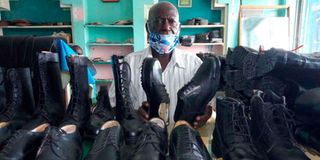How revival of textile, leather industries will employ millions

James Musyoka at his Loyals Small-Scale Leather Industry in 2020. He makes shoes among other leather items.
Two weeks ago, I recounted how banning of second-hand clothes would benefit livestock farmers. From engagements I have had with various readers since then by phone, text and face-to-face, it appears that the country has survived on second-hand clothes for so long that a large number of people cannot figure out how the textiles and leather industries would transform Kenya’s economy.
The questions I have received have mainly been on the plight of those who cannot afford new clothes. Some have wondered what would happen to all those people trading in second-hand clothes, from importation to hawking.
Kamau from Kiambu, who I met on a farm during my routine work, told me he sells second-hand clothes to fellow workers on the farm and neighbouring areas. He wondered what he would do if the clothes were banned.
I told him before the 80s, second-hand clothes were extremely few and there were still small and large-scale clothes traders who sold new clothes. They were affordable because they were locally made. There were textile industries like Kisumu Cotton Mills (Kicomi), Thika Textiles and Rift Valley Textiles (Rivatex).
The textile companies were large and profitable enough to the point of forming and sponsoring football teams. This goes to show how a vibrant textile industry gives rise to growth in other sectors.
Employment creation
Jane from Murang’a told me she would like to understand further how the textile and leather industries would create large numbers of jobs. For us to understand how the country is losing big on industrialisation and employment creation by sticking to second-hand clothes, we should first appreciate that textiles and leather products are the most consumed items after food.
Textiles and leather industries combined are the second largest employer in any country after the food industry. This is because they are related to the number of people in each country and the export market. Second, producing textile and leather items requires a long process that involves many other sectors and skilled and unskilled labour.
The textile industry encompasses fashion designers, production and distribution of yarn, cloth and garments from the factories down the chain to retail outlets. The raw materials may be natural such as cotton, jute, fur, wool, hair and silk. These are grown and harvested by farmers. Fibres could also be synthetic, such as acrylic, produced by chemical industries. Chemical industries also produce the dyes that are used to colour both fabric and leather.
I believe by now it is evident that the textile and leather industries are huge opportunities for Kenya’s industrialisation and employment creation. Production in the two industries should be targeted both at the domestic and export markets. It is unfortunate that Africa trades more with the other continents, especially Europe, Asia and America rather than trading with herself first.
The value of the African textile trade is estimated at $31 million in 2021, equivalent to Sh3.6 trillion. India, on the other hand, has a value of $140 billion or Sh16.4 trillion. The African continent and India have roughly the same population of about 1.4 billion people.
India directly employs about 35 million people in her textile industry. Kenya’s population is estimated at 56 million, according to United Nations data. If the textile industry in Kenya got developed to the Indian status, the country could directly employ over 1.4 million people. This does not include the farmers and farm workers involved in production of natural textile fibre. The leather industry is a bit different. The steps involved are production of animals, slaughter and harvesting of hides and skins. The hides and skins are then processed into leather which is used by product designers and manufacturers to produce the highly valued leather items.
Global leather industry
Leather items are varied, prestigious and highly priced. They include shoes, belts, jackets, handbags, wallets, buttons, hats, gloves and ornaments. There are also items such as furniture and musical instruments like drums.
The global leather industry is valued at $100 billion annually or about Sh12 trillion. The Kenyan leather industry value is about Sh50 billion annually or $430 million. About 90 per cent of the country’s leather export is the low value partially processed wet blue leather.
Full processing of the leather could create at least 50,000 additional jobs and earn the country an extra $150 to $250 million.
Kenya is the fifth largest cattle producer in Africa after Ethiopia, Chad, Sudan and Tanzania. Yet our leather trade is very small. That means most of our leather goes to waste, which is a lost opportunity for employment creation, improved livelihoods and revenue collection by the government.
Considering the Kenyan and African population and the encouragement of the continent to trade with itself, developing the textiles and leather industries is a grand opportunity for Kenya’s industrialisation and creation of sustainable employment. People will always dress. They will also always value leather and animal fibre products because there will never be enough raw material to supply everyone.





